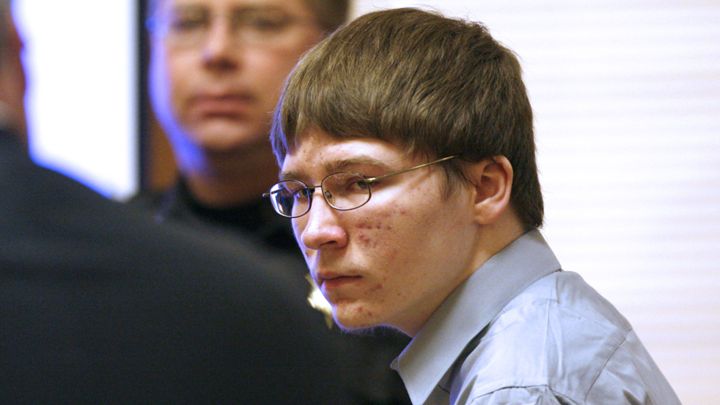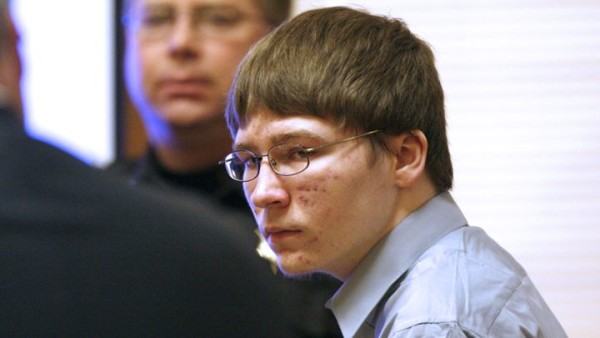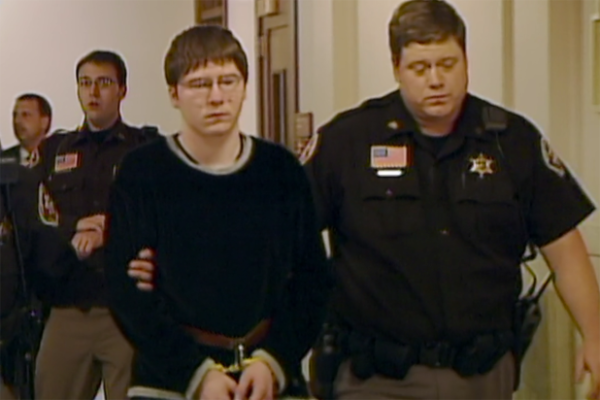

Nancy Grace is on a mission to make sure that “Making a Murderer‘s” main characters Steven Avery and Brendan Dassey are proven guilty in the media to make sure she’s not proven wrong. She’s unveiled this confession/interrogation of Brendan Dassey that wasn’t in the Netflix documentary.
The media is suddenly pointing fingers at the filmmakers, treating them as if they created this 10 part docu-series in the hopes of getting Avery exonerated, and they’ve come out to have their say finally on this.
The confession below will sound familiar to many people who followed the “West Memphis Three” case involving Damien Echols, Jason Baldwin and Jesse Misskelley Jr. Misskelley was brought in for questioning and wound up being the lynchpin for the West Memphis police department to bring in Echols and Baldwin. Misskelley recanted, but the prosecution was able to use him for media’s sake, but they knew that he’d be a wildcard much like Dassey was.
The confession might sound odd to those that haven’t seen the Netflix series, “Making a Murderer,” but this is how Dassey talked. After this confession, he was expecting to go home, much like Jesse Misskelley Jr, who was very similar in IQ.
Following this is a breakdown of contamination in a confession/interrogation.
At age 16, Brendan Dassey admitted in a four-hour confession to raping, killing and dismembering 25-year-old Teresa Halbach with his uncle, Steven Avery, a Wisconsin auto salvage owner who’d previously served 18 years for a rape he did not commit. Dassey, whose I.Q. is below 70, is currently serving a life sentence for his role in the crime. The following portions of Dassey’s confession, which were elicited without a defense lawyer present, were not included in Netflix’s Making a Murderer series — but HLN host Nancy Grace recently shared with media outlets.
BRENDAN DASSEY INTERROGATION
MAY 13, 2006 – CALUMET CO. SHERIFF’S OFFICE
DASSEY: He went to go pick up some stuff around the yard then after that we, he asked me to come in the house cuz he wanted to show me somethin’. And he showed me that she was laying on the bed, her hands were roped up to the bed and that her legs were cuffed. And then he told me to have sex with her and so I did because I thought I was not gonna get away from ’em cuz he was too strong, so I did what he said and then after that, he untied her and uncuffed her and then he brought her outside and before he went outside, he told me to grab her clothes and her shoes. So we went into the garage and before she went out, when before he took her outside, he had tied up her hands and feet and then was in the garage and he stabbed her and then he told me to. And, after that he wanted to make sure she was dead or somethin’ so he shot her five times and while he was doing that I wasn’t looking because I can’t watch that stuff. So I was standing by the big door in the garage and then after that, he took her outside and we put her on the fire and we used her clothes to clean up the, some of the blood. And, when we put her in the fire, and her clothes, we were standing right by the garage, to wait for it to get down so we threw some of that stuff on it after it went down.
“He was gonna take her out to the garage.”
POLICE: Come on, Brendan. What’s he telling her at this time? We know there’s some talking going on, OK. We, we know that.
BRENDAN: That he said that he was gonna take her out to the garage and stab her and shoot her.
POLICE: He actually says that to her or does he say that to you or who’s he saying that to?
BRENDAN: To both of us.
POLICE: And what is she saying when he tells her that?
BRENDAN: To not do that.
POLICE: Does he have a weapon at this time when he’s untying her and tying her back up?
BRENDAN: Well, when he was done roping her her roped her, he grabbed the gun and then he grabbed her.
“Where does he stab her?”
POLICE: OK. Let’s start with when you bring her out to the garage. Where do you put her?
DASSEY: On the floor.
POLICE: And continue, tell us what happens.
DASSEY: And then he stabs her and then he tells me to and then he puts her into the jeep and then he said he would rather burn her so then he put her back on the floor and then he shot her five times.
POLICE: Where does he stab her?
DASSEY: In the chest.
POLICE: Show me where.
DASSEY: Like right here.
POLICE: Where do you stab her?
DASSEY: In the stomach.
POLICE: What does she say when you stab her?
DASSEY: To stop what I was doin’.
POLICE: What’s that? Is she screaming?
DASSEY: Yeah.
POLICE: Is she screaming and saying stop what you’re doing? Is she swearing at you? Is she struggling or what? Tell us how that happened.
DASSEY: Just that she was crying a lot.
POLICE: Are you holding her down?
DASSEY: No.
POLICE: Who is?
DASSEY: Steven is.
“Five shots”
POLICE: And I’m not gonna sit here Brendan and allow you to lie to me anymore. I don’t need you to. I’ve got enough evidence without you. If you wanna help yourself, you have that opportunity right now to do that. Is that what you wanna do? Do you wanna help yourself? Then why are you lying? Look at me Brendan. Brendan? Brendan. Brendan.
DASSEY: What?
POLICE: Look at me once.
DASSEY: I don’t want to.
POLICE: Why? Do you wanna continue this and talk with us and be honest with us so we can get through this, get this off your chest?
DASSEY: The last time I seen the gun was on th-the rack.
POLICE: OK. Did you shoot her?
DASSEY: No.
POLICE: How many times did Steve shoot her?
POLICE: To the best of your memory.
DASSEY: Well I heard five shots.
“Were you involved?”
POLICE: Were you involved with the murder of Teresa Halbach, yes or no?
DASSEY: Yes.
POLICE: Who else was involved with it?
DASSEY: Steven.
POLICE: Steven who?
DASSEY: Avery.
POLICE: OK, anybody else?
DASSEY: No.
“Planned this”
POLICE: Why did you go over there? You had this stuff planned out already, didn’t you? You and Steve had this planned? Yeah? Yes or no?
DASSEY: Yeah.
POLICE: OK and when did you plan it?
DASSEY: For a few days.
POLICE: OK. And what did you have planned? Tell me what you had planned. Come on. Brendan did you have this planned? Yes or no?
BRENDAN: Yes.
POLICE: Who did you plan it with?
DASSEY: Steven.
POLICE: When?
DASSEY: A few days before it happened.
POLICE: OK, and what did you have planned to do? (pause) The details are easy, come on, you’ve already given me that you were involved in it, so just go on with the details, paint the picture for me. Obviously I know already, I know a bunch of this already. I keep proving that to you. The details are easy, just tell me what you guys planned and what you did, no sweat.
DASSEY: That I had sex with her.
“Why did he pick Teresa?”
POLICE: Why did he pick Teresa?
DASSEY: Cuz she was comin’ over that day.
POLICE: Did he tell you she was coming over? Did he tell you she was coming over?
DASSEY: Yeah.
POLICE: And what did he say he was going to do?
DASSEY: That he was gonna to kill her.
POLICE: Did he say why?
DASSEY: No.
POLICE: Did he tell you to come over then? To help him or what did he tell you? What did he tell you Brendan?
DASSEY: That he wanted me to help ’em.
POLICE: And did you agree to do that?
DASSEY: Yeah.
“What Steven was gonna do”
POLICE: Did he tell you about Teresa, that he had met her before?
DASSEY: Yeah. POLICE: OK. Tell me about that. What did he say about her?
DASSEY: That she looked good and she was pretty nice.
POLICE: OK. Did he tell ya where she worked?
DASSEY: No.
POLICE: Did he tell ya how he was gonna get her in the house?
DASSEY: No.
POLICE: How did he, do you know?
DASSEY: No.
POLICE: OK. So a couple days prior you said there this lady he knows or tell me how he says that. I don’t wanna put words in your mouth, tell me how he says it to you.
DASSEY: That he had a girl coming over to take a picture of a van.
POLICE: OK. What else?
DASSEY: And then that he would do that to her.
POLICE: No, wha-tell me exactly what he said.
DASSEY: That he would kill her.
POLICE: Did he laugh about it or what? Why did, why did he say he was gonna kill her?
DASSEY: ‘Cause he was pissed off that Jodi was in jail again.
 An attorney breaks down how the confession/interrogation was contaminated
An attorney breaks down how the confession/interrogation was contaminated
The techniques used to interrogate 16-year-old Brendan Dassey about the 2005 killing of Teresa Halbach “were a recipe for a false confession,” one of his attorneys said Friday.
Steven Drizin, co-founder of Northwestern University’s Center for Wrongful Convictions of Youth, which is appealing Dassey’s case in federal court, said the techniques also run counter to the book “Criminal Interrogation and Confessions,” a leading resource on interrogation techniques used by police.
“Brendan’s confession is one of the most contaminated confessions I’ve ever seen,” Drizin told media outlets. “He keeps getting wrong answers, and the interrogators keep correcting him and feeding him the answers they want to hear.”
The manner in which Dassey’s confession was elicited has raised concerns following the release of the Netflix series “Making a Murderer,” which recaps the convictions of Dassey and his uncle, Steven Avery, in the murder of Halbach, a 25-year-old photographer who disappeared after she visited Avery Auto Salvage near Mishicot.
The concerns aren’t limited to Dassey’s defense team, nor to Wisconsin.
Ralph DeMarco of San Diego said he believes Dassey “is as innocent as the driven snow.” He came to the conclusion after watching the documentary and then reading the transcripts of Dassey’s interrogations.
“I haven’t been able to sleep since I waded through the progression of multiple coercive interrogations this helpless teenager endured with no adult support for his many claims of innocence,” DeMarco said.
Reid technique
The book “Criminal Interrogations and Confessions” presents a nine-step process of interrogation known as the Reid technique. Drizin said it is the most widely used interrogation training technique in the United States.
Drizin said the Reid technique tries to limit a suspect’s alternatives to the lesser of two evils: one explanation suggested is the suspect is a cold, calculating murderer; the other explanation suggested is some kind of face-saving excuse.
“Those kinds of techniques are highly coercive when used with teenagers and children because their assessment of risk, their understanding of long-term consequences, is developmentally different than with regard to adults,” Drizin said. “They’re looking at short-term rewards. ‘What do I have to say to stop this interrogation and to get out of this room and go home.’ That’s their primary interest.”
Toward the end of “Making a Murderer,” Mark Fremgen, Dassey’s trial attorney, says the Reid technique is designed “to elicit confessions, not get to the truth.”
The statement drew a rebuke from Joseph P. Buckley, president of John E. Reid and Associates of Chicago and one of the authors of the 2013 edition of “Criminal Interrogations and Confessions.”
Buckley said that Reid’s training materials describe “what to look for as a possible indication of innocence during the interrogation process.”
Reid and Associates’ literature also says interrogators must exercise extreme caution when dealing with juveniles or people with mental or psychological impairments. Dassey had a low IQ and was interrogated without the presence of a parent or attorney when he confessed.
“Certainly these individuals can and do commit very serious crimes,” Reid and Associates says, “but since many false confession cases involve juveniles and/or individuals with some significant mental or psychological disabilities, extreme care must be exercised when questioning these individuals and the investigator has to modify their approach with these individuals.”
Book vs. reality
Drizin acknowledges the cautions in the Reid book, but he said there is a disconnect between what’s in the book and what Reid covers in its training sessions. He said most police officers don’t read the book.
The distinction between interrogation techniques applicable to adults and those applicable to juveniles or individuals with low social maturity or cognitive disabilities isn’t discussed in the training, Drizin said.
“I can’t account for every single training that Reid does, but my colleagues have been to their trainings, and I have viewed all of their video trainings,” he said. “The notion that there is distinction between how you interrogate kids and how you interrogate adults doesn’t come through in their trainings.”
During the interrogation of Dassey, detectives Mark Wiegert and Tom Fassbender:
- Suggest to Dassey that they will help him and that leniency will follow if he confesses.
- Fictitiously claim they have evidence that links Dassey to the crime.
- Feed him facts that only the killer would know.
Such persuasive techniques should be avoided when interrogating juveniles with low social maturity or diminished mental capacity, according to Reid.
“These suspects may not have the fortitude or confidence to challenge such evidence and, depending on the nature of the crime, may become confused as to their own possible involvement if the police tell them evidence clearly indicates they committed the crime,” the book says.
Drizin said the help theme was used repeatedly in the interrogation of Dassey. “They said, ‘We’re here to help you, Brendan.’ ‘We’re in your corner.’ ‘We’re thinking that even if you involve yourself more in the crime, you will be OK,'” Drizin said. “Those kinds of statements certainly should never be used with juveniles and suggestible suspects like Brendan.”
Buckley and others at Reid and Associates did not return telephone calls and emails seeking comment for this story.
Drizin said a publication by the International Association of Chiefs of Police titled “Reducing Risks: An Executive’s Guide to Effective Juvenile Interview and Interrogation” instructs police how to interrogate suspects in a way to reduce the risk of false or coerced confessions.
Dassey’s case
“Making a Murderer” has produced an outpouring of support for Dassey, not necessarily that he is innocent, but that his confession was coerced and that he deserves a new trial.
An emphasis of the Reid technique is that interrogators must not disclose facts about the investigation to a suspect because the best way to determine whether the suspect is giving a true confession is for the suspect to provide those facts without any prompting or persuasion by officers.
In the Dassey interrogation, Wiegert introduces the notion that Halbach was shot in the head.
Manitowoc County Circuit Judge Jerome Fox ruled that although police misled the teen in a March 1, 2006, interrogation, the confession was given voluntarily and was admissible as evidence. Dassey denied involvement in the crime during his trial.
Drizin said Dassey didn’t realize the seriousness of the situation during the interrogation — he asked whether he would be released in time to make his sixth-hour class because he had a project due — and was manipulated by promises that the truth will set him free.
“Brendan is a concrete thinker,” Drizin said. “He’s not really capable of abstract thought. When you tell him, ‘The truth will set you free,’ he thinks he’s going to go home if he tells you what you want to hear.”


